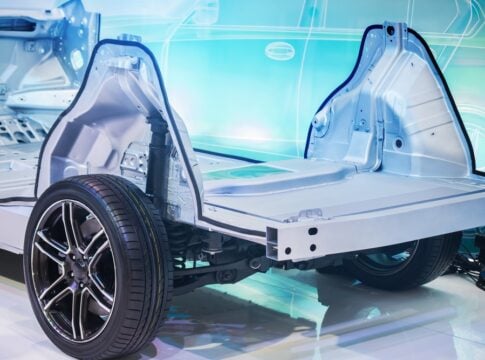The nuclear energy landscape in North America is undergoing a significant transformation, with both the US and Canada making strides to bolster their nuclear capabilities. From reviving uranium enrichment in the US to Canada’s embrace of nuclear financing, the region is on the road to a nuclear energy resurgence.
Breaking U.S. Nuclear Dependence
The US uranium enrichment sector stands to receive a substantial $2.7 billion injection as part of a government funding bill. This initiative reflects a strategic move to reduce reliance on nuclear fuel imported from Russia.
Proposed by the White House, the funding is integral to President Joe Biden’s broader plan to procure enriched uranium directly from domestic sources. The goal is to revitalize nearly dormant US capabilities by establishing a guaranteed buyer for American-made nuclear reactor fuel.
The move coincides with potential legislative measures to restrict imports of enriched uranium from Russia. The NO RUSSIA bill, National Opportunity to Restore Uranium Supply Services In America Act of 2022, expels Russia’s influence from the U.S. uranium market.
The provision of enrichment funding is based upon implementing limitations on the importation of enriched Russian uranium. The fund is from a credit program for domestic nuclear reactors established in the bipartisan infrastructure law of 2022.
The allocated funding is specially dedicated to cultivating a market for domestically produced enriched uranium. This uranium serves as fuel for the US fleet of over 90 nuclear reactors, as well as for highly enriched uranium used in emerging advanced reactor technologies, currently monopolized by Russia.
In December 2023, after over 50 years, the U.S. issued approval for a groundbreaking nuclear reactor developed by Kairos Power.
The California-based startup has been granted a construction permit by the Nuclear Regulatory Commission (NRC) for its Hermes demonstration reactor in Tennessee. The novel reactor uses molten fluoride salt as a coolant, a more efficient technology than conventional water-cooled nuclear reactors.
The NRC has also granted certifications to other innovative nuclear developers, e.g. NuScale Power and Centrus Energy Corporation, in collaboration with the Energy Department. Most initiatives involved small nuclear reactors (SMR), generating under 300 MWe capacity.
These developments indicate a shifting regulatory stance toward innovative approaches to nuclear power generation in the U.S.
Financing the Canadian Nuclear Renaissance
Over in Canada, the federal government amended its green bond programs. They now permit the financing of nuclear projects and navigated an initial test of investor support for this energy source.
Notably, about 15% of the country’s electricity comes from nuclear power. Most of the 19 reactors are in Ontario which provides 13.6 GWe of power capacity.
 The sovereign and the province of Ontario issued a combined C$5.5 billion or US$4.1 billion in securities. This marked the first two offerings under the revised Green Bond Framework for green debt that allow funding for nuclear initiatives. Previously, the framework didn’t include nuclear energy from getting financial support.
The sovereign and the province of Ontario issued a combined C$5.5 billion or US$4.1 billion in securities. This marked the first two offerings under the revised Green Bond Framework for green debt that allow funding for nuclear initiatives. Previously, the framework didn’t include nuclear energy from getting financial support.
The recent $4 billion issuance by the Canadian sovereign did not explicitly earmark proceeds for nuclear power projects. Still, the federal government emphasized its commitment to nuclear development. Also, investors have eagerly subscribed to the 10-year debt offering, with orders surpassing $7.4 billion, nearly double the final amount.
Powering Ahead: Canada’s Ambitious Nuclear Expansion Plans
Canada aims to develop both new large-scale nuclear capacity and SMRs. In 2018, Natural Resources Canada (NRCan) unveiled its SMR Roadmap, outlining a strategic plan for the advancement of nuclear technology centered around SMRs.
In February 2023, the Canadian government initiated the Enabling Small Modular Reactors Program. It allocates about US$22 million to facilitate the advancement and implementation of SMRs.
Another notable nuclear development in Canada is Ontario’s 2015 decision to greenlight the refurbishment or lifetime extension of 4 nuclear units at Darlington and the remaining 6 units at Bruce (with the initial 2 units already refurbished). This ambitious C$26 billion 15-year program stands as one of the most significant clean energy endeavors in North America.
Bruce Power, an Ontario-based company aiming to construct the world’s largest nuclear power plant, announced that all its future bonds will adhere to green financing principles. The nuclear power developer also introduced at COP28 last year the first carbon offset protocol for nuclear generation.
James Scongack, Bruce Power’s Chief Development Officer, noted that investor appetite for green securities is shaping their future fundraising strategies. He further noted that:
“With the demand we see for green bonds, we have no doubt all future bonds funding nuclear projects will be green bonds.”
The inclusion of nuclear projects reflects a growing acceptance of nuclear power to decarbonize and enhance energy security. This development signifies a significant shift in green finance and underscores the evolving role of nuclear energy in Canada’s sustainability efforts.
By embracing nuclear power, the US and Canada are paving the way for a sustainable energy landscape while enhancing energy security.
The post Funding Bill Grants $2.7B to American-Made Nuclear Reactor Fuel appeared first on Carbon Credits.
Carbon Footprint
Tesla Rides High Before Q3 Earnings With (TSLA) Stock Rising, Record Deliveries, Gigafactory Growth, and Green Goals
Tesla, Inc. continues to show strong performance in 2025. In the third quarter alone, the company delivered 497,099 vehicles, close to half a million units. This figure is one of Tesla’s highest quarterly delivery totals on record. At the same time, its Austin Gigafactory reached a key production milestone — more than 500,000 vehicles built since opening in 2022.
These achievements confirm Tesla’s steady expansion of its manufacturing network. The company now runs major factories in California, Texas, Nevada, Germany, and China. Each plant contributes to a growing global supply chain that supports its Model Y, Model 3, and the new Cybertruck.
Tesla’s steady ramp-up shows how far it has come since its early production struggles. The company aims to reach 20 million vehicles a year by 2030. This plan is ambitious, but this quarter’s numbers show steady progress toward that goal.
Gigafactory Texas Reaches a Key Milestone
Gigafactory Texas, near Austin, is Tesla’s biggest and most advanced U.S. facility. It makes the Model Y and is ramping up Cybertruck production. Hitting 500,000 vehicles in roughly three and a half years shows faster growth compared to Tesla’s earlier plants.
Reports say around 100,000 vehicles were made from April to mid-October 2025. This strong pace helps meet annual growth targets. The plant uses Giga Presses, which are massive casting machines that replace dozens of smaller parts. This automation speeds up production, reduces costs, and minimizes material waste.
The Texas facility also plays a central role in Tesla’s sustainability strategy. Much of its electricity comes from renewable energy, and its design reduces water use and waste. Over time, Tesla aims for all Gigafactories to operate with 100% clean energy.
Q3 Earnings Outlook: Revenue Growth, Margin Pressure
Analysts expect Tesla to post around $26.3 billion in revenue for Q3 2025, up about 4–5% year-over-year. However, earnings per share (EPS) are projected to fall about 24%, to roughly $0.55 per share from $0.72 in the same quarter last year.
The decline is mainly due to lower vehicle prices and smaller contributions from carbon redit sales. These credits have been providing a huge revenue stream to the EV giant by selling it to its peers that don’t meet regulatory emission reductions.
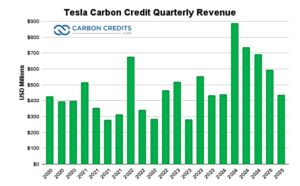
Also, Tesla has cut prices on its main models in several markets to stay competitive, especially against Chinese EV makers. Those price cuts attract new buyers but reduce profit margins.
Tesla’s operating margin averaged 9.2% in Q2 2025, down from 11.4% a year earlier. Automotive gross margin, excluding credits, was about 18%, compared to over 25% in 2022. Even with tighter margins, Tesla continues to benefit from software revenue through Full Self-Driving (FSD) packages and connectivity subscriptions.
The company’s results will likely depend on several key factors:
- Vehicle deliveries – nearly half a million this quarter.
- Energy storage deployments – reaching a new record of 12.5 GWh.
- Software and services – providing recurring, higher-margin income.
- Production costs – influenced by logistics and raw material expenses.
Despite margin pressure, Tesla’s growth in energy storage and software could offset some of the decline in car profits.
The Global EV Race Accelerates
The global electric vehicle (EV) market continues to expand rapidly. The International Energy Agency (IEA) reports that global EV sales rose over 30% in 2024. They reached almost 14 million units. In 2025, sales could hit 17 million. Electric cars could represent about 22% of all vehicle sales globally by the end of this year.

Tesla remains a market leader, holding around 16% of global EV market share, but it faces rising competition. Chinese brands like BYD, NIO, and XPeng are growing in Asia and Europe. At the same time, Volkswagen, Ford, GM, and Hyundai are speeding up EV production.
Elon Musk’s company defends its position by improving efficiency and cutting costs. Its 4680 battery cells are key, aiming to lower production costs by up to 50%. They also enhance range and durability.
The company also benefits from the U.S. Inflation Reduction Act (IRA), which offers tax credits for EV buyers and incentives for battery production. However, these credits will gradually phase out, which could affect demand after 2026.
According to BloombergNEF, the average price of lithium-ion batteries dropped to $115 per kWh in 2024, down 20% from 2023. This decline helps Tesla maintain affordability while protecting margins.
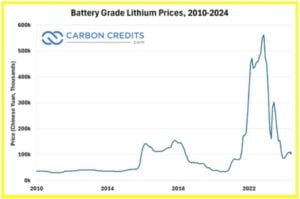
Wall Street Takes the Wheel: Tesla Stock Gains on Big Deliveries
Tesla’s stock rose modestly after its Q3 delivery report. On Monday, shares gained, surpassing $444, which doubled in six months. The rise reflects investor confidence in Tesla’s production capacity and delivery strength, even with profit pressure.
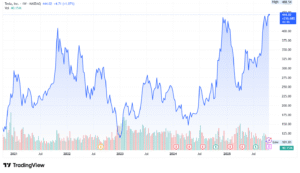
Analysts remain split: some expect stronger earnings in 2026 as new models roll out, while others warn that price cuts and competition could slow growth.
Still, Tesla’s ability to maintain high output while scaling its energy business supports its long-term outlook. The company is a top choice for big investors like BlackRock and Vanguard. They both focus on sustainability in their investment strategies.
- SEE MORE: Tesla (TSLA) Stock Rises Over $450, Hits Record $1.5T Market Cap as Q3 Delivery Test Looms
Driving Clean: Tesla’s Growing Role in a Net-Zero World
Tesla’s business model directly supports global emission-reduction goals. Tesla’s 2024 Impact Report shows that customers avoided almost 32 million metric tons of CO₂e emissions. This is a 60% increase from last year. This figure includes emissions avoided by Tesla’s vehicles as well as its solar and energy storage products globally.
Since 2012, Tesla’s fleet has avoided many millions of metric tons of CO₂e. Each vehicle saves about 52 metric tons of CO₂e compared to similar gasoline cars over an average lifespan of 17 years.
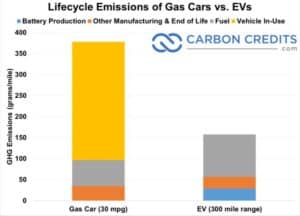
Tesla also focuses on sustainable manufacturing:
- Gigafactory Nevada recycles more than 92% of production waste and reduces its water use intensity by 12% year-over-year.
- The company sources lithium and aluminum from suppliers following responsible mining and low-carbon standards.
- Its battery recycling program recovers up to 95% of nickel, cobalt, and lithium for reuse.
Beyond vehicles, Tesla’s energy business is expanding fast. In 2024, the company deployed 15 GWh of energy storage through its Megapack and Powerwall systems — enough to power over 4 million homes for one hour. These systems help utilities store renewable energy, stabilize grids, and reduce fossil fuel reliance.
Tesla aims to reach net-zero emissions across its value chain by 2040, covering factories, logistics, and product lifecycles. Investments in solar, wind, and carbon reduction projects are key to that goal.
Roadblocks and Roadmaps: What’s Next for Tesla
Amid its strong momentum, Tesla still faces several challenges that could affect future growth:
- Competition: Rivals are narrowing the gap in technology and cost.
- Price pressure: Discounts to boost demand reduce profitability.
- Regulatory risks: Autopilot and FSD remain under scrutiny in some markets.
- Supply chain: Securing critical minerals like lithium and nickel remains essential.
To adapt, Tesla is diversifying. The company plans to launch a low-cost compact vehicle, often referred to as the Model 2, expected to be priced under $27,000 and launched in late 2026.
It’s also developing a robotaxi platform, codenamed CyberCab, expected to begin pilot operations in 2026 with Level 4 autonomy. Plus, Tesla Energy could exceed $10 billion in annual revenue by 2026, supported by growing Megapack demand in the U.S. and Europe.
Tesla’s Q3 2025 milestones highlight both progress and pressure. Delivering nearly 500,000 vehicles and producing 500,000 at its Texas plant shows major strides in sustainable mobility. Revenue continues to grow even as profits tighten.
As Tesla prepares to announce its Q3 earnings, investors will look for signs of balance — growth, profitability, and sustainability. If the company keeps expanding responsibly and investing in cleaner technologies, it will remain a central player in the global transition toward a zero-emission economy.
The post Tesla Rides High Before Q3 Earnings With (TSLA) Stock Rising, Record Deliveries, Gigafactory Growth, and Green Goals appeared first on Carbon Credits.
Carbon Footprint
How NVIDIA, Microsoft, Musk’s xAI, and BlackRock Are Driving the Next Wave of AI: $60 Billion in Mega Deals Explained
NVIDIA continues to cement its position as a leading force in the artificial intelligence (AI) industry. Its powerful chips are now the foundation of massive data centers and AI systems across the world. Recent deals worth more than $60 billion highlight how deeply the company is shaping the future of global computing.
Industries like healthcare and finance are turning to AI. NVIDIA’s hardware and software are now key to digital transformation. The company is both selling chips as well as designing the global infrastructure for smart technologies.
Growing Global Demand for AI Computing
Modern AI models demand enormous computing power. Training chatbots, autonomous driving systems, or image-recognition tools involves processing millions of calculations per second. NVIDIA’s graphics processing units (GPUs) are built for this type of workload.
Unlike traditional chips, GPUs can handle many tasks at once, making them ideal for AI training and inference. NVIDIA’s efficiency has made it the go-to supplier for big cloud providers, research institutions, and AI startups.
In 2025, global demand for AI computing surged. Governments and private companies are building large-scale data centers around NVIDIA’s technology. These facilities help create advanced AI models. They can be used for tasks like weather forecasting and logistics optimization.
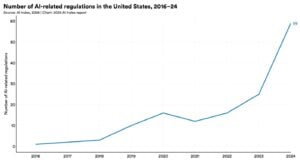
Billions in Global Infrastructure Partnerships
NVIDIA has signed major partnerships worth about $60 billion in total. These include agreements across cloud services, chip deployment, and full-scale data center construction.
A key highlight is the $14 billion contract between Microsoft and Nscale, a British AI cloud company. This deal will deploy about 200,000 NVIDIA GB300 GPUs. The installations will span the United States and Europe, with 104,000 GPUs located at a 240-megawatt facility in Texas set to open in 2026. Additional sites include 12,600 GPUs in Portugal and 23,000 in England by 2027.
Another big deal includes BlackRock, Microsoft, NVIDIA, and Elon Musk’s xAI. They just announced a $40 billion purchase of Aligned Data Centers. The company operates over 50 campuses with more than 5 gigawatts of total capacity across North and South America. This is the biggest data center purchase ever. It also boosts NVIDIA’s role in the AI Infrastructure Partnership (AIP) initiative.
NVIDIA is more than a chip supplier now. These big collaborations show it’s a key partner in creating and powering the next generation of AI infrastructure.
Musk Bets Big on NVIDIA in a $20B Chip Pact
One of the most ambitious projects tied to NVIDIA is xAI’s $20 billion lease-to-own deal for AI chips. Led by Elon Musk, xAI plans to use the financing to build the Colossus 2 data center in Memphis, Tennessee.
The project will deploy 300,000 to 550,000 NVIDIA GB200 and GB300 chips, scaling up from xAI’s current 200,000-processor facility. The arrangement involves about $7.5 billion in equity and $12.5 billion in debt, using a special purpose vehicle (SPV) structure.
In a unique twist, NVIDIA is investing up to $2 billion in the SPV’s equity, effectively financing part of its own hardware. The debt is secured by the GPUs, not xAI’s corporate assets. This gives lenders direct security linked to the equipment.
This five-year lease model helps xAI access cutting-edge computing power without taking on the full debt burden. It also ensures NVIDIA a steady income stream and longer-term control over chip distribution.
NVIDIA Stock Moving Up, Market Going Up
NVIDIA’s stock went up a bit today. The market responded to corporate announcements and infrastructure deals. The gain shows that investors believe these big deals will increase future revenue and strengthen NVIDIA’s position in the AI ecosystem.
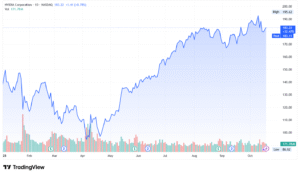
Although the increase isn’t dramatic, it shows that traders view this news as adding value. Stable stock gains can draw more interest from institutional investors. They look for long-term growth potential.
As news about these deals spreads, more people in the market may view NVIDIA as more than just a chipmaker. They might see it as a key player in AI infrastructure. That perception can help support longer-term stock strength.
The AI infrastructure market is growing fast and looks set to keep expanding for years. Analysts estimate the AI-infrastructure market hit $87.6 billion in 2025. It could almost double by 2030. This growth comes as companies invest in GPUs, networking, and cooling systems.
Data center power needs are rising fast. Forecasts suggest that by 2027, demand could hit about 92 GW. This growth is mainly due to AI workloads.
Firms and governments might need trillions in new capital to meet demand. One major study estimates that data-center investments could reach about $8 trillion by 2030 in a high-growth scenario.
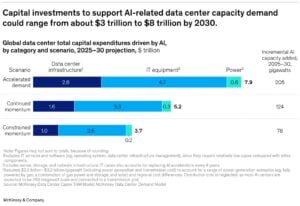
Market research groups predict that AI data centers will grow at a compound annual growth rate of 25–32% through 2030. This means strong ongoing investment in chips, facilities, and power.
ESG, Sustainability, and Environmental Impact
Large AI data centers, like those powered by NVIDIA’s chips, have significant environmental footprints. The energy they consume and the cooling systems they require can contribute to greenhouse gas emissions and heavy water use.
In the xAI Colossus 2 project, the energy demand alone is over 1 gigawatt, comparable to the power needs of nearly a million households. Cooling will use millions of gallons of water daily. The facility uses methane turbines. This has led to complaints from environmental groups about air pollution and regulatory issues.
Because of this, NVIDIA and its partners will need to address sustainability. They may invest in cleaner power sources like solar or wind. They might also implement advanced cooling technology that uses less water or captures waste heat. Efficient chip designs that consume less power will be critical, too.
These sustainability efforts can influence public perception, regulatory approvals, and long-term cost structure. If NVIDIA proves it’s cutting emissions and lowering environmental impact, it boosts its role as a tech leader and a responsible partner for a greener future.
The Heat Is On: Rivals, Regulation, and Rising Power Costs
Despite its momentum, NVIDIA faces real challenges. Global demand for GPUs still exceeds supply, leading to long waiting times for deliveries. The company depends on semiconductor foundries like TSMC. So, any delays in production can affect big projects.
Competition is growing as well. AMD, Intel, and new AI-focused startups are developing their own advanced processors. These firms aim to capture part of the rapidly expanding AI chip market.
NVIDIA also faces regulatory and environmental risks. Export limits might cut sales in important areas. Also, AI data centers use more energy, which brings up sustainability issues. Meeting demand responsibly will require cleaner energy sources and more efficient chip designs.
What’s Next: NVIDIA’s AI Empire Expands
Looking ahead, NVIDIA is expected to continue expanding its global partnerships and data center influence. The company could move deeper into AI infrastructure services, offering combined packages of chips, software, and cloud capacity.
Future growth may also come from:
- AI-as-a-Service platforms for governments and enterprises.
- Cloud partnerships that give smaller developers access to advanced GPUs.
- Next-generation chip designs with better performance per watt.
- Sustainability initiatives to reduce energy use and emissions in data centers.
NVIDIA’s new partnerships include $60 billion in infrastructure deals and $20 billion in chip leasing. These moves show its growing role in AI innovation. The company’s chips now support projects that define the next era of computing, from massive data centers to advanced autonomous systems.
While competition and environmental pressures will continue to test its leadership, NVIDIA’s global reach and ability to adapt ensure it will stay a key player in the race to build the world’s AI infrastructure.
The post How NVIDIA, Microsoft, Musk’s xAI, and BlackRock Are Driving the Next Wave of AI: $60 Billion in Mega Deals Explained appeared first on Carbon Credits.
Carbon Footprint
Aluminum Prices Hit 3-Year High: Is It the Next Key Metal in the Clean Energy Shift?
Aluminum is moving from a supporting role to center stage in the global green transition. The metal is light and strong, and also endlessly recyclable. This makes it essential for electric vehicles (EVs), solar panels, power lines, and low-carbon buildings.
Global demand for aluminum is rising fast as countries expand renewable power and electric transport. The International Aluminium Institute (IAI) expects aluminum demand to rise by 40% by 2030. This growth is fueled by clean-tech uses.
But as the market expands, so does scrutiny on emissions. Aluminum smelting is one of the most energy-intensive industrial processes in the world. Reducing its carbon footprint is now a top goal for both industry and governments.
Aluminum Prices Hit 3-Year High Amid Tight Supply
On October 10, 2025, aluminum prices surged to their highest level in three years, topping around $2,800 per tonne. The rally shows rising supply worries and increasing demand from clean energy sectors. This includes electric vehicles (EVs), renewable power, and construction.
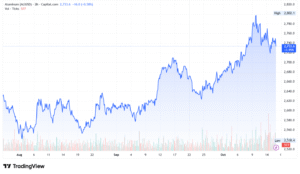
Analysts attribute the spike to several factors. China’s power shortages have limited smelting output. Also, new environmental rules are tightening production limits on coal-powered plants. In addition, unrest in Guinea, which supplies over 45% of China’s bauxite imports, has raised fears of disruptions in the global supply chain.
Meanwhile, inventories tracked by the London Metal Exchange fell to their lowest point since 2021, signaling a tightening market.
“Supply can’t keep up with the clean-energy boom,” said analysts from BloombergNEF. They pointed out that aluminum’s use in solar, EVs, and transmission lines is growing faster than producers can adapt.
The recent price rise shows that investors prefer low-carbon aluminum. This type of aluminum now has a significant premium. Demand for verified low-emission materials is outpacing supply. This is the case for automakers, construction firms, and renewable developers in Europe and North America.
Experts think that prices over $2,500 per tonne could boost investments in recycling and renewable-powered smelters. This is especially true in places like Canada, Norway, and the Middle East. However, the rally also underscores a broader challenge: balancing the green transition with resource security.
Why Aluminum Is the Unsung Hero of Clean Energy
Aluminum saves weight — and that means energy. Lighter cars and trucks travel farther on the same battery charge. According to the Aluminum Association, modern EVs use 30–40% more aluminum than traditional gas vehicles.
It’s not just cars. Each 1-MW solar farm uses roughly 40 tons of aluminum for panel frames, mounts, and wiring. Power grids also rely on aluminum for transformers and long-distance transmission lines.
The metal’s high recyclability adds major sustainability value. Recycled aluminum uses only 5% of the energy required for primary production. Yet recycling accounts for only about 36% of global aluminum output today, leaving huge room for expansion.
The low-carbon aluminum market was 19.3 million tons in 2024, per IMARC estimates. It can grow to 27.7 million tons by 2033, with an annual growth rate of 3.7%. That growth mirrors global renewable investment trends.

China’s Dominance and the Global Supply Imbalance
China dominates the aluminum industry. It produces over 40 million tons of primary aluminum annually — nearly 60% of global supply. It also tops in refining and processing, as well as in demand for raw materials like bauxite.

Exports of bauxite from Guinea to China jumped 35% in 2024, making Guinea the world’s top bauxite exporter. This raw material feeds China’s vast smelting network.
Worldwide, primary aluminum production has topped 70 million tons in recent years. But the carbon footprint varies greatly by location.
Smelters powered by coal — common in parts of China — emit far more CO₂ than those powered by renewables. Producers in Norway, Iceland, and Canada use hydropower. They create aluminum with emissions below 4 kg CO₂ per kg aluminum. This is much lower than the global average of 16.7 kg CO₂ per kg (IAI, Hydro).
This huge gap shows why energy source matters as much as output in the global supply chain.
The Emissions Problem — and Low-Carbon Solutions
Traditional aluminum production is energy-hungry. The International Energy Agency (IEA) estimates that aluminum accounts for around 2% of global CO₂ emissions from materials production.
Producers are now turning to renewable power and recycled inputs to cut this footprint. Norsk Hydro, for example, produces low-carbon aluminum emitting only 3 kg CO₂/kg, among the world’s cleanest.
If all smelters switched to renewable power, global aluminum emissions could fall by 400 million tonnes of CO₂ each year. That’s like the yearly emissions from 100 coal plants.

Recycling is another big win. Recycling rates in Europe could double by 2030, potentially saving 39 million tonnes of CO₂ per year by 2050. Globally, if all used aluminum were recycled, the industry’s total energy demand could fall by 60%, says MARC Group.
Pricing, Premiums, and the Push for Low-Carbon Metal
Aluminum remains a major commodity. The global aluminum market was valued at roughly $190 billion in 2024, with steady growth projected through 2030.
The IAI forecasted the following for aluminum demand growth by 2030:
-
By Region:
Around 93% of global aluminum demand growth between 2020 and 2030 will come from Asia (especially China), Europe, and North America, reflecting industrial expansion, renewable power deployment, and strong EV manufacturing in these regions.
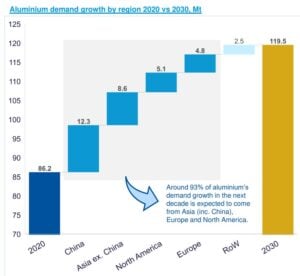
-
By Sector:
Aluminum demand is set to grow most in transportation (+11.8 Mt), followed by electrical (+5.2 Mt), construction (+4.6 Mt), and packaging (+3.3 Mt) — with transport leading due to electric mobility and the electrical sector driven largely by solar and renewable infrastructure. -
By EV Demand:
Electric vehicles will account for roughly 63% of new aluminum demand in transport, adding about 7.4 million tonnes by 2030; EVs use 60–80 kg more aluminum per vehicle than traditional models, with China, Europe, and North America driving about 93% of this growth.
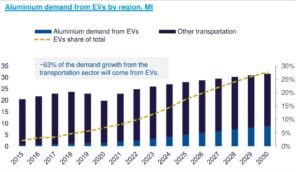
Low-carbon aluminum commands a premium. Market data shows that buyers pay $20 to $150 per tonne more for certified low-carbon products, depending on the region and energy source.
Smelters that use renewable power gain a cost edge as carbon pricing expands. For instance, hydropower-based smelters in Iceland and Quebec report operating costs up to 30% lower than coal-based plants in China.
Investment in renewable-powered smelting hubs is also accelerating. In 2025, new projects in Europe, Canada, and the Middle East are expected to increase global capacity for low-carbon aluminum by 3–4 million tons.
Industry Moves, Policy Levers, and Challenges Ahead
Automakers, electronics makers, and construction firms are driving the shift. Mercedes-Benz, Apple, and Volvo all signed long-term contracts for low-carbon aluminum to cut supply chain emissions.
The European Union’s Carbon Border Adjustment Mechanism (CBAM), set to take effect in 2026, will tax imports based on embedded CO₂. This policy will pressure high-emission producers to decarbonize faster.
Governments are also funding clean smelting projects. In 2025, the U.S. Department of Energy awarded over $500 million program. This program aims to boost aluminum decarbonization and improve recycling infrastructure.
Countries rich in bauxite, like Guinea and Indonesia, are enjoying higher global demand. However, they also face pressure to improve environmental standards in mining and refining.
Scaling low-carbon aluminum faces three main challenges:
- Energy transition: Replacing fossil electricity with renewables near smelters requires billions in new investments.
- Recycling infrastructure: Global collection systems remain fragmented; less than 40% of post-consumer scrap is recovered.
- Verification: Without strict standards, false “green aluminum” claims risk damaging trust.
Aluminum could become one of the biggest enablers of decarbonization. Every tonne of low-carbon aluminum can reduce lifecycle emissions in cars, solar farms, and power lines by several tonnes of CO₂.
To meet climate goals, producers, investors, and governments must collaborate. Expanding renewable energy for smelting is key. Scaling up recycling is also important, as well as having traceable and verified supply chains to succeed.
With the right policies and innovation, aluminum can become a cleaner material. It can support the energy transition by helping create lighter, stronger, and more sustainable systems.
The post Aluminum Prices Hit 3-Year High: Is It the Next Key Metal in the Clean Energy Shift? appeared first on Carbon Credits.
-
Climate Change2 years ago
Spanish-language misinformation on renewable energy spreads online, report shows
-
Climate Change2 months ago
Guest post: Why China is still building new coal – and when it might stop
-
Climate Change Videos2 years ago
The toxic gas flares fuelling Nigeria’s climate change – BBC News
-

 Greenhouse Gases1 year ago
Greenhouse Gases1 year ago嘉宾来稿:满足中国增长的用电需求 光伏加储能“比新建煤电更实惠”
-
Greenhouse Gases2 months ago
Guest post: Why China is still building new coal – and when it might stop
-

 Climate Change1 year ago
Climate Change1 year ago嘉宾来稿:满足中国增长的用电需求 光伏加储能“比新建煤电更实惠”
-

 Carbon Footprint2 years ago
Carbon Footprint2 years agoUS SEC’s Climate Disclosure Rules Spur Renewed Interest in Carbon Credits
-
Renewable Energy3 months ago
US Grid Strain, Possible Allete Sale




